roof PONTIAC VIBE 2010 Owners Manual
[x] Cancel search | Manufacturer: PONTIAC, Model Year: 2010, Model line: VIBE, Model: PONTIAC VIBE 2010Pages: 318, PDF Size: 1.7 MB
Page 1 of 318
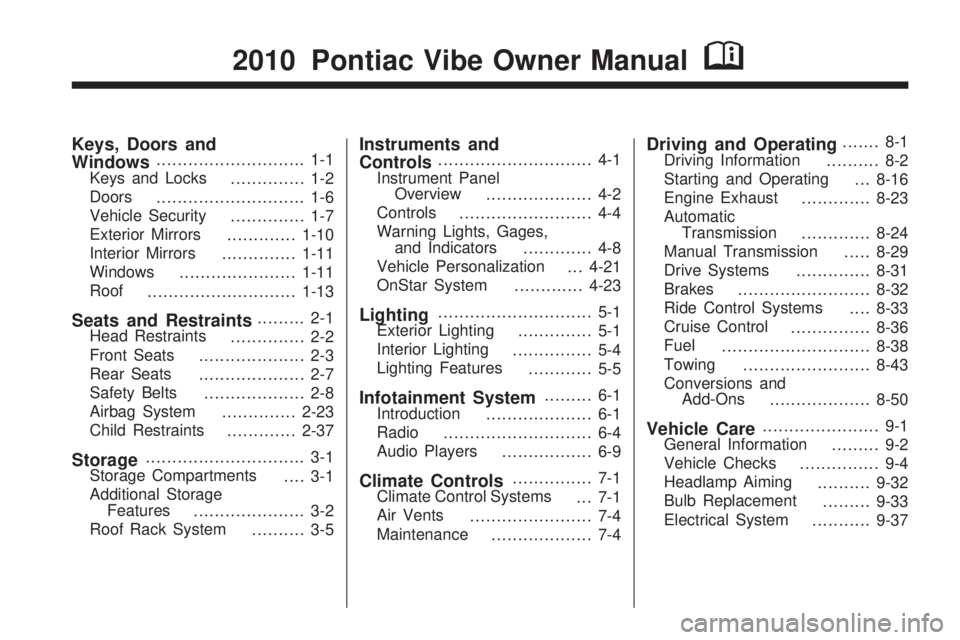
Keys, Doors and
Windows............................ 1-1
Keys and Locks .............. 1-2
Doors ............................ 1-6
Vehicle Security .............. 1-7
Exterior Mirrors .............1-10
Interior Mirrors ..............1-11
Windows ...................... 1-11
Roof ............................ 1-13
Seats and Restraints......... 2-1
Head Restraints .............. 2-2
Front Seats .................... 2-3
Rear Seats .................... 2-7
Safety Belts ................... 2-8
Airbag System ..............2-23
Child Restraints .............2-37
Storage.............................. 3-1
Storage Compartments .... 3-1
Additional Storage Features ..................... 3-2
Roof Rack System .......... 3-5
Instruments and
Controls............................. 4-1
Instrument Panel Overview .................... 4-2
Controls ......................... 4-4
Warning Lights, Gages, and Indicators ............. 4-8
Vehicle Personalization . . . 4-21
OnStar System .............4-23
Lighting............................. 5-1
Exterior Lighting .............. 5-1
Interior Lighting ............... 5-4
Lighting Features ............ 5-5
Infotainment System......... 6-1
Introduction .................... 6-1
Radio ............................ 6-4
Audio Players ................. 6-9
Climate Controls............... 7-1
Climate Control Systems ... 7-1
Air Vents ....................... 7-4
Maintenance ................... 7-4
Driving and Operating....... 8-1
Driving Information .......... 8-2
Starting and Operating . . . 8-16
Engine Exhaust .............8-23
Automatic Transmission .............8-24
Manual Transmission .....8-29
Drive Systems ..............8-31
Brakes ......................... 8-32
Ride Control Systems ....8-33
Cruise Control ...............8-36
Fuel ............................ 8-38
Towing ........................ 8-43
Conversions and Add-Ons ................... 8-50
Vehicle Care...................... 9-1
General Information ......... 9-2
Vehicle Checks ............... 9-4
Headlamp Aiming ..........9-32
Bulb Replacement .........9-33
Electrical System ...........9-37
2010 Pontiac Vibe Owner ManualM
Page 7 of 318
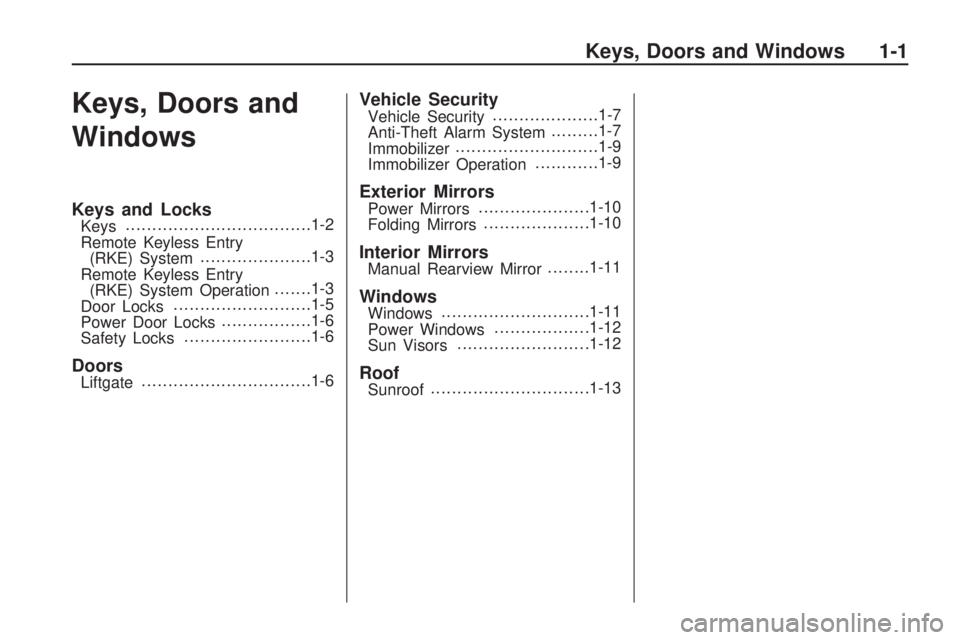
Keys, Doors and
Windows
Keys and LocksKeys..................................
.1-2
Remote Keyless Entry (RKE) System ....................
.1-3
Remote Keyless Entry (RKE) System Operation .......1-3
Door Locks .........................
.1-5
Power Door Locks ................
.1-6
Safety Locks .......................
.1-6
DoorsLiftgate...............................
.1-6
Vehicle SecurityVehicle Security...................
.1-7
Anti-Theft Alarm System .........1-7
Immobilizer ..........................
.1-9
Immobilizer Operation ............1-9
Exterior MirrorsPower Mirrors....................
.1-10
Folding Mirrors ...................
.1-10
Interior MirrorsManual Rearview Mirror ........1-11
WindowsWindows...........................
.1-11
Power Windows .................
.1-12
Sun Visors ........................
.1-12
RoofSunroof.............................
.1-13
Keys, Doors and Windows 1-1
Page 19 of 318
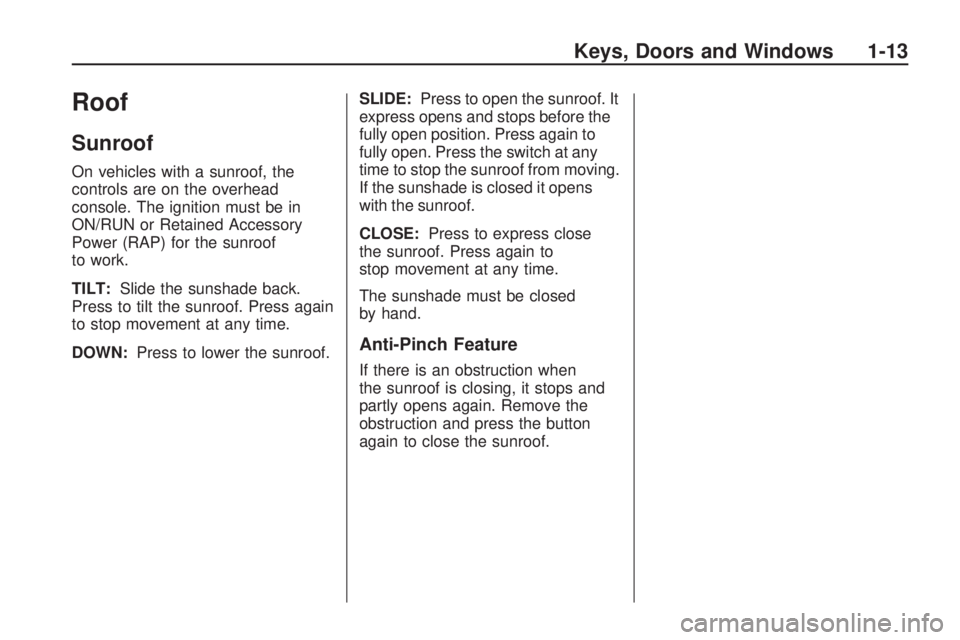
Roof
Sunroof
On vehicles with a sunroof, the
controls are on the overhead
console. The ignition must be in
ON/RUN or Retained Accessory
Power (RAP) for the sunroof
to work.
TILT:Slide the sunshade back.
Press to tilt the sunroof. Press again
to stop movement at any time.
DOWN: Press to lower the sunroof. SLIDE:
Press to open the sunroof. It
express opens and stops before the
fully open position. Press again to
fully open. Press the switch at any
time to stop the sunroof from moving.
If the sunshade is closed it opens
with the sunroof.
CLOSE: Press to express close
the sunroof. Press again to
stop movement at any time.
The sunshade must be closed
by hand.
Anti-Pinch Feature
If there is an obstruction when
the sunroof is closing, it stops and
partly opens again. Remove the
obstruction and press the button
again to close the sunroof.
Keys, Doors and Windows 1-13
Page 43 of 318

Airbag System
This vehicle has the following
airbags:
•A frontal airbag for the driver.
•A frontal airbag for the right front
passenger.
The vehicle may have the following
airbags:
•A seat-mounted side impact
airbag for the driver.
•A seat-mounted side impact
airbag for the right front
passenger.
•A roof-rail airbag for the driver
and the passenger seated
directly behind the driver.
•A roof-rail airbag for the
right front passenger and the
passenger seated directly behind
the right front passenger. All of the airbags in the vehicle will
have the word AIRBAG embossed in
the trim or on an attached label near
the deployment opening.
For frontal airbags, the word
AIRBAG will appear on the middle
part of the steering wheel for the
driver and on the instrument panel
for the right front passenger.
With seat-mounted side impact
airbags, the word AIRBAG
will appear on the side of the
seatback closest to the door.
With roof-rail airbags, the word
AIRBAG will appear along the
headliner or trim.
Airbags are designed to supplement
the protection provided by safety
belts. Even though today’s airbags
are also designed to help reduce the
risk of injury from the force of an
inflating bag, all airbags must inflate
very quickly to do their job. Here are the most important things
to know about the airbag system:
{CAUTION
You can be severely injured or
killed in a crash if you are not
wearing your safety belt — even if
you have airbags. Airbags are
designed to work with safety belts,
but do not replace them. Also,
airbags are not designed to deploy
in every crash. In some crashes
safety belts are your only restraint.
See
When Should an Airbag
In�ate? on page 2-26.
Wearing your safety belt during a
crash helps reduce your chance of
hitting things inside the vehicle or
being ejected from it. Airbags are
“supplemental restraints” to the
safety belts. Everyone in your
vehicle should wear a safety belt
properly — whether or not there
is an airbag for that person.
Seats and Restraints 2-23
Page 44 of 318
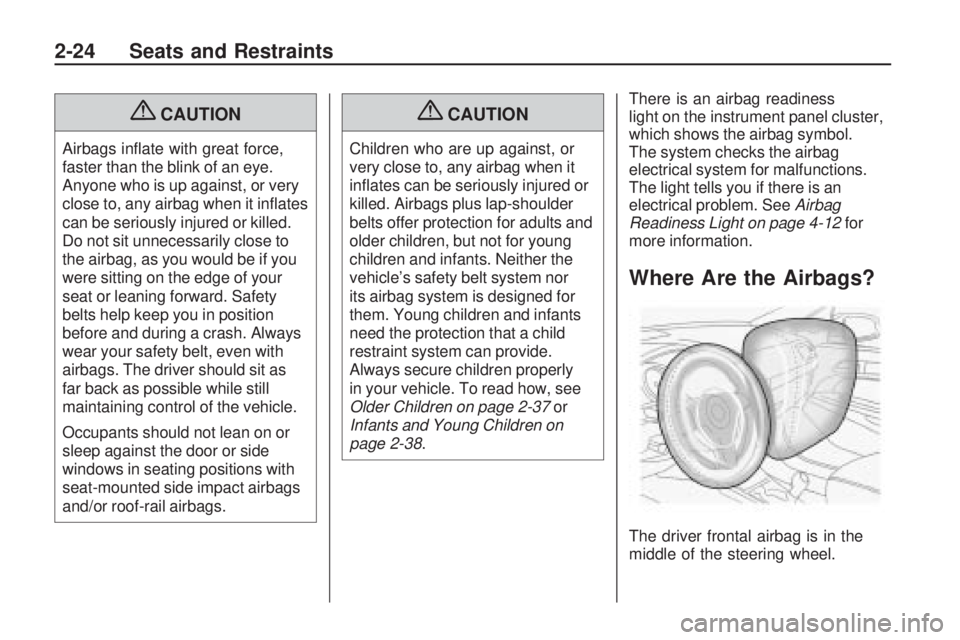
{CAUTION
Airbags inflate with great force,
faster than the blink of an eye.
Anyone who is up against, or very
close to, any airbag when it inflates
can be seriously injured or killed.
Do not sit unnecessarily close to
the airbag, as you would be if you
were sitting on the edge of your
seat or leaning forward. Safety
belts help keep you in position
before and during a crash. Always
wear your safety belt, even with
airbags. The driver should sit as
far back as possible while still
maintaining control of the vehicle.
Occupants should not lean on or
sleep against the door or side
windows in seating positions with
seat-mounted side impact airbags
and/or roof-rail airbags.
{CAUTION
Children who are up against, or
very close to, any airbag when it
inflates can be seriously injured or
killed. Airbags plus lap-shoulder
belts offer protection for adults and
older children, but not for young
children and infants. Neither the
vehicle’s safety belt system nor
its airbag system is designed for
them. Young children and infants
need the protection that a child
restraint system can provide.
Always secure children properly
in your vehicle. To read how, see
Older Children on page 2-37or
Infants and Young Children on
page 2-38. There is an airbag readiness
light on the instrument panel cluster,
which shows the airbag symbol.
The system checks the airbag
electrical system for malfunctions.
The light tells you if there is an
electrical problem. See
Airbag
Readiness Light on page 4-12 for
more information.
Where Are the Airbags?
The driver frontal airbag is in the
middle of the steering wheel.
2-24 Seats and Restraints
Page 45 of 318
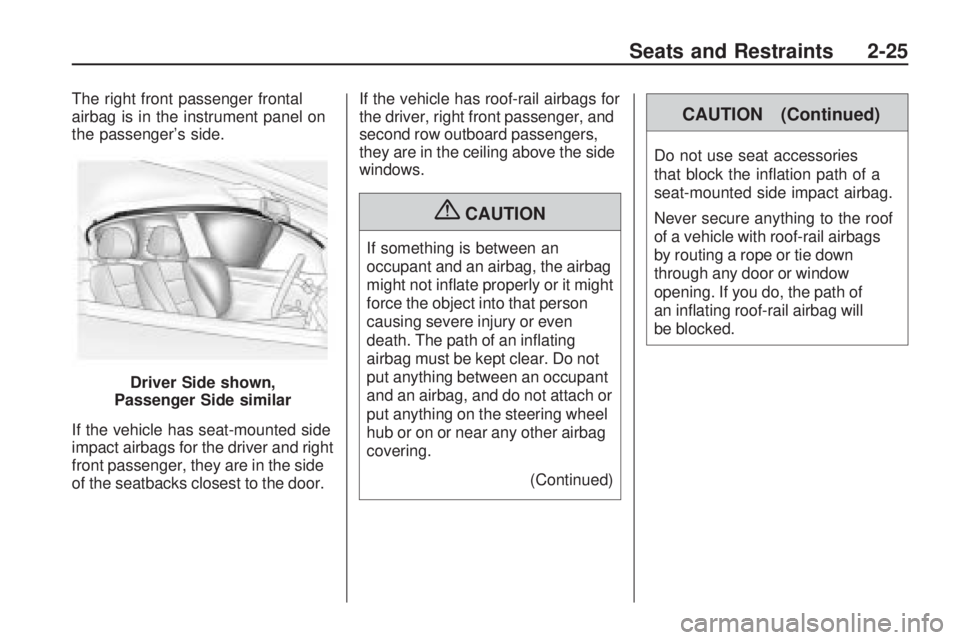
The right front passenger frontal
airbag is in the instrument panel on
the passenger’s side.
If the vehicle has seat-mounted side
impact airbags for the driver and right
front passenger, they are in the side
of the seatbacks closest to the door.If the vehicle has roof-rail airbags for
the driver, right front passenger, and
second row outboard passengers,
they are in the ceiling above the side
windows.
{CAUTION
If something is between an
occupant and an airbag, the airbag
might not inflate properly or it might
force the object into that person
causing severe injury or even
death. The path of an inflating
airbag must be kept clear. Do not
put anything between an occupant
and an airbag, and do not attach or
put anything on the steering wheel
hub or on or near any other airbag
covering.
(Continued)
CAUTION (Continued)
Do not use seat accessories
that block the inflation path of a
seat-mounted side impact airbag.
Never secure anything to the roof
of a vehicle with roof-rail airbags
by routing a rope or tie down
through any door or window
opening. If you do, the path of
an inflating roof-rail airbag will
be blocked.
Driver Side shown,
Passenger Side similar
Seats and Restraints 2-25
Page 47 of 318
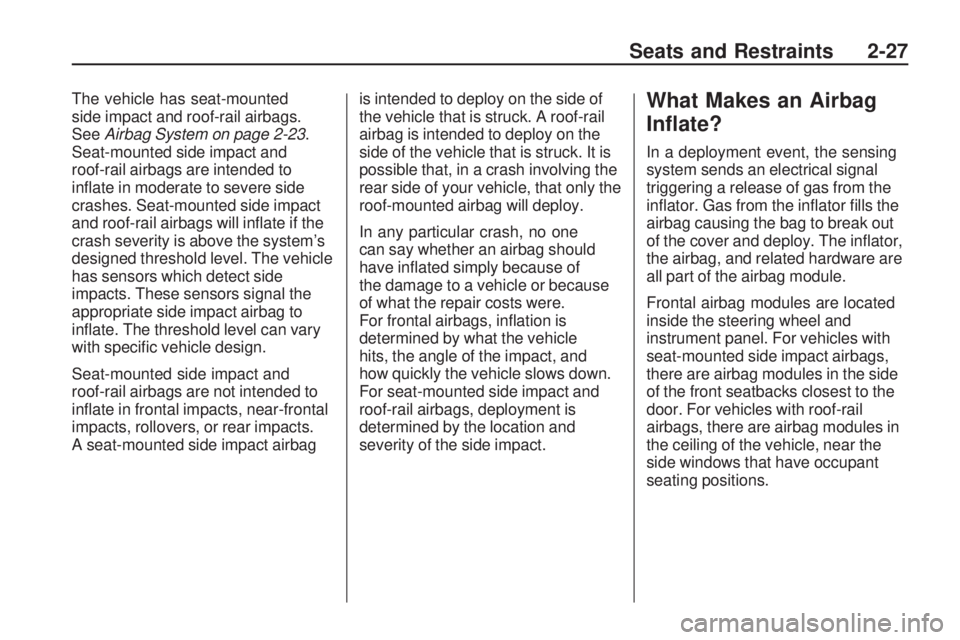
The vehicle has seat-mounted
side impact and roof-rail airbags.
SeeAirbag System on page 2-23 .
Seat-mounted side impact and
roof-rail airbags are intended to
inflate in moderate to severe side
crashes. Seat-mounted side impact
and roof-rail airbags will inflate if the
crash severity is above the system’s
designed threshold level. The vehicle
has sensors which detect side
impacts. These sensors signal the
appropriate side impact airbag to
inflate. The threshold level can vary
with specific vehicle design.
Seat-mounted side impact and
roof-rail airbags are not intended to
inflate in frontal impacts, near-frontal
impacts, rollovers, or rear impacts.
A seat-mounted side impact airbag is intended to deploy on the side of
the vehicle that is struck. A roof-rail
airbag is intended to deploy on the
side of the vehicle that is struck. It is
possible that, in a crash involving the
rear side of your vehicle, that only the
roof-mounted airbag will deploy.
In any particular crash, no one
can say whether an airbag should
have inflated simply because of
the damage to a vehicle or because
of what the repair costs were.
For frontal airbags, inflation is
determined by what the vehicle
hits, the angle of the impact, and
how quickly the vehicle slows down.
For seat-mounted side impact and
roof-rail airbags, deployment is
determined by the location and
severity of the side impact.What Makes an Airbag
In�ate?
In a deployment event, the sensing
system sends an electrical signal
triggering a release of gas from the
inflator. Gas from the inflator fills the
airbag causing the bag to break out
of the cover and deploy. The inflator,
the airbag, and related hardware are
all part of the airbag module.
Frontal airbag modules are located
inside the steering wheel and
instrument panel. For vehicles with
seat-mounted side impact airbags,
there are airbag modules in the side
of the front seatbacks closest to the
door. For vehicles with roof-rail
airbags, there are airbag modules in
the ceiling of the vehicle, near the
side windows that have occupant
seating positions.
Seats and Restraints 2-27
Page 48 of 318
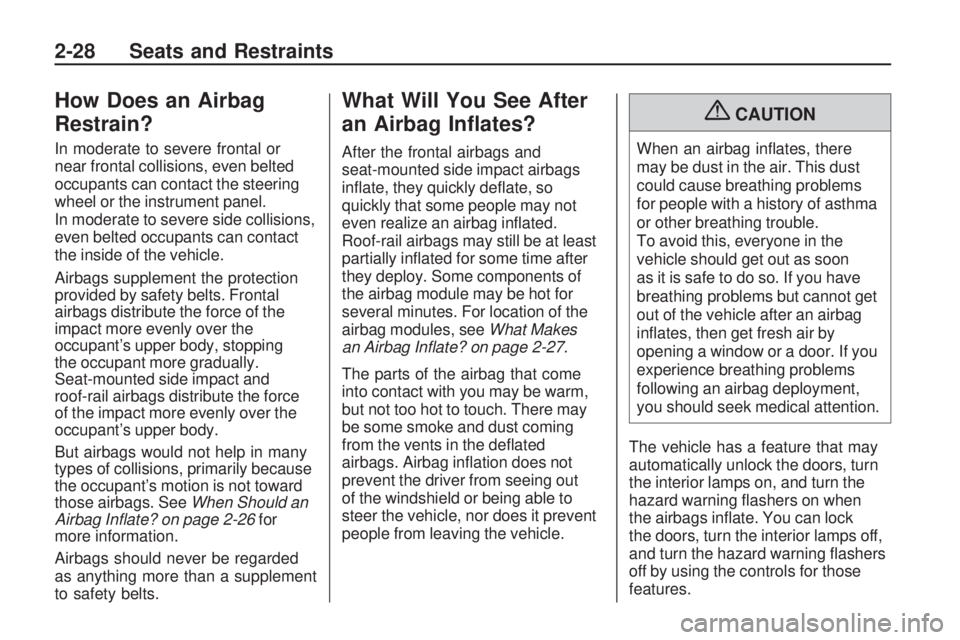
How Does an Airbag
Restrain?
In moderate to severe frontal or
near frontal collisions, even belted
occupants can contact the steering
wheel or the instrument panel.
In moderate to severe side collisions,
even belted occupants can contact
the inside of the vehicle.
Airbags supplement the protection
provided by safety belts. Frontal
airbags distribute the force of the
impact more evenly over the
occupant’s upper body, stopping
the occupant more gradually.
Seat-mounted side impact and
roof-rail airbags distribute the force
of the impact more evenly over the
occupant’s upper body.
But airbags would not help in many
types of collisions, primarily because
the occupant’s motion is not toward
those airbags. SeeWhen Should an
Airbag In�ate? on page 2-26 for
more information.
Airbags should never be regarded
as anything more than a supplement
to safety belts.
What Will You See After
an Airbag In�ates?
After the frontal airbags and
seat-mounted side impact airbags
inflate, they quickly deflate, so
quickly that some people may not
even realize an airbag inflated.
Roof-rail airbags may still be at least
partially inflated for some time after
they deploy. Some components of
the airbag module may be hot for
several minutes. For location of the
airbag modules, see What Makes
an Airbag In�ate? on page 2-27 .
The parts of the airbag that come
into contact with you may be warm,
but not too hot to touch. There may
be some smoke and dust coming
from the vents in the deflated
airbags. Airbag inflation does not
prevent the driver from seeing out
of the windshield or being able to
steer the vehicle, nor does it prevent
people from leaving the vehicle.
{CAUTION
When an airbag inflates, there
may be dust in the air. This dust
could cause breathing problems
for people with a history of asthma
or other breathing trouble.
To avoid this, everyone in the
vehicle should get out as soon
as it is safe to do so. If you have
breathing problems but cannot get
out of the vehicle after an airbag
inflates, then get fresh air by
opening a window or a door. If you
experience breathing problems
following an airbag deployment,
you should seek medical attention.
The vehicle has a feature that may
automatically unlock the doors, turn
the interior lamps on, and turn the
hazard warning flashers on when
the airbags inflate. You can lock
the doors, turn the interior lamps off,
and turn the hazard warning flashers
off by using the controls for those
features.
2-28 Seats and Restraints
Page 49 of 318

In many crashes severe enough to
inflate the airbag, windshields are
broken by vehicle deformation.
Additional windshield breakage
may also occur from the right front
passenger airbag.
•Airbags are designed to inflate
only once. After an airbag inflates,
you will need some new parts for
the airbag system. If you do not
get them, the airbag system will
not be there to help protect you
in another crash. A new system
will include airbag modules and
possibly other parts. The service
manual for your vehicle covers
the need to replace other parts.
•The vehicle has a crash sensing
and diagnostic module which
records information after a crash.
SeeVehicle Data Recording and
Privacy on page 12-14 andEvent
Data Recorders on page 12-14 .
•Let only qualified technicians work
on the airbag systems. Improper
service can mean that an airbag
system will not work properly.
See your dealer/retailer for
service.
Passenger Sensing
System
The vehicle has a passenger
sensing system for the right front
passenger position. The passenger
airbag status indicator will be visible
in the instrument panel when the
vehicle is started.
The words ON and OFF will be
visible during the system check.
When the system check is complete,
either the word ON or the word OFF will be visible depending on
whether the seat is occupied and/or
the weight of the occupant. If the
seat is unoccupied, the light will not
be visible after the system check.
See
Passenger Airbag Status
Indicator on page 4-13 .
The passenger sensing system will
turn off the right front passenger
frontal airbag and seat-mounted
side impact airbag under certain
conditions. The driver airbags and
the roof-rail airbags are not affected
by the passenger sensing system.
The passenger sensing system will
also turn off the right front passenger
frontal airbag, seat-mounted side
impact airbag (if equipped), and
safety belt pretensioner if it detects
that there is no occupant in that
position.
The passenger sensing system
works with sensors that are part
of the right front passenger seat.
Seats and Restraints 2-29
Page 55 of 318
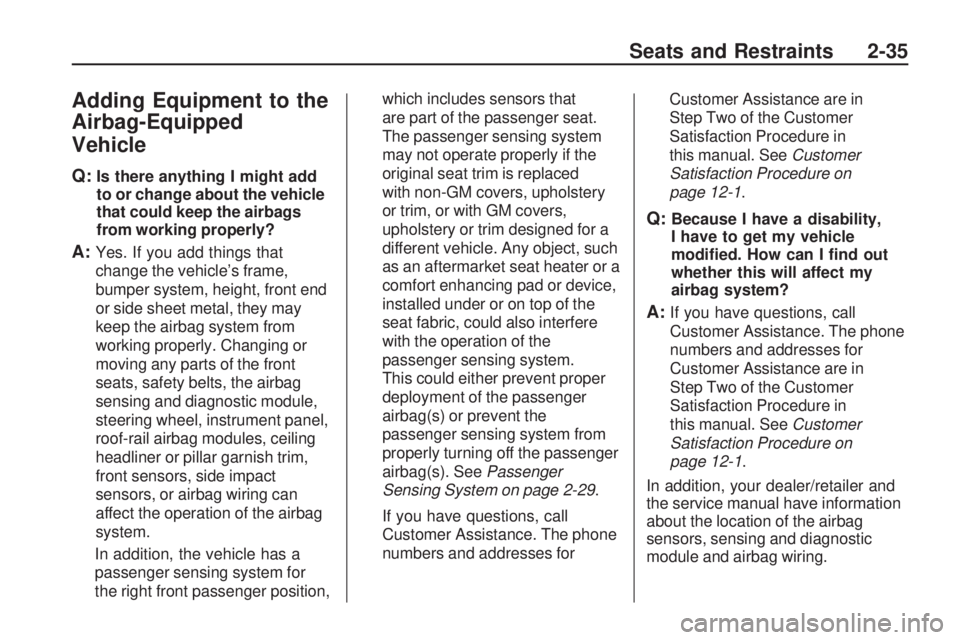
Adding Equipment to the
Airbag-Equipped
Vehicle
Q:Is there anything I might add
to or change about the vehicle
that could keep the airbags
from working properly?
A:Yes. If you add things that
change the vehicle’s frame,
bumper system, height, front end
or side sheet metal, they may
keep the airbag system from
working properly. Changing or
moving any parts of the front
seats, safety belts, the airbag
sensing and diagnostic module,
steering wheel, instrument panel,
roof-rail airbag modules, ceiling
headliner or pillar garnish trim,
front sensors, side impact
sensors, or airbag wiring can
affect the operation of the airbag
system.
In addition, the vehicle has a
passenger sensing system for
the right front passenger position, which includes sensors that
are part of the passenger seat.
The passenger sensing system
may not operate properly if the
original seat trim is replaced
with non-GM covers, upholstery
or trim, or with GM covers,
upholstery or trim designed for a
different vehicle. Any object, such
as an aftermarket seat heater or a
comfort enhancing pad or device,
installed under or on top of the
seat fabric, could also interfere
with the operation of the
passenger sensing system.
This could either prevent proper
deployment of the passenger
airbag(s) or prevent the
passenger sensing system from
properly turning off the passenger
airbag(s). See
Passenger
Sensing System on page 2-29 .
If you have questions, call
Customer Assistance. The phone
numbers and addresses for Customer Assistance are in
Step Two of the Customer
Satisfaction Procedure in
this manual. See
Customer
Satisfaction Procedure on
page 12-1.
Q:Because I have a disability,
I have to get my vehicle
modi�ed. How can I �nd out
whether this will affect my
airbag system?
A:If you have questions, call
Customer Assistance. The phone
numbers and addresses for
Customer Assistance are in
Step Two of the Customer
Satisfaction Procedure in
this manual. See Customer
Satisfaction Procedure on
page 12-1.
In addition, your dealer/retailer and
the service manual have information
about the location of the airbag
sensors, sensing and diagnostic
module and airbag wiring.
Seats and Restraints 2-35